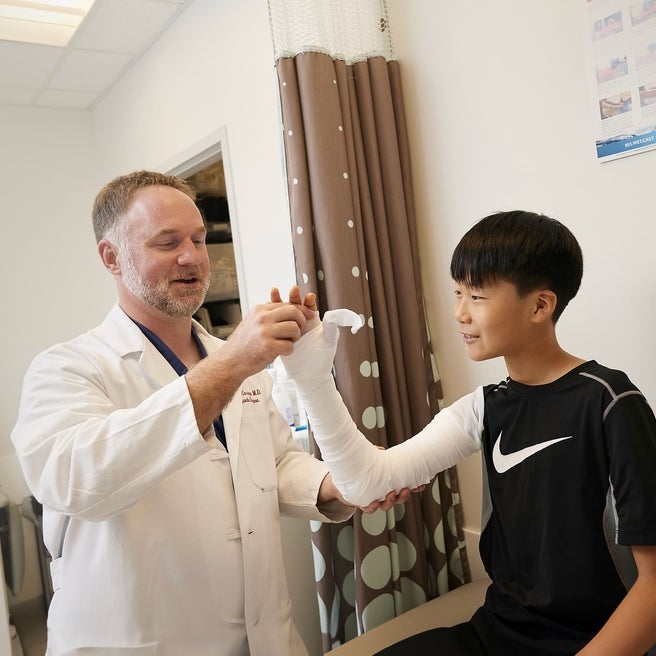What is anterior knee pain?
Anterior knee pain is pain at the front and center of the knee, which occurs when the kneecap doesn't move properly or rubs against the lower part of the thigh bone. Anterior knee pain is a broad term that encompasses runner's knee, jumper's knee, patellofemoral pain syndrome (PFPS), chondromalacia patella and patellar tendonitis.
Your child's kneecap (patella) is positioned over the front of the knee joint. When your child bends or straightens their knee, the underside of the kneecap glides in a groove, called the “trochlea”, at the end of the thigh bone (femur). Attaching to the patella are two tendons that help to connect the thigh muscles to the shin bone, allowing the knee to go into extension when the muscles are activated. These include the quadriceps tendon (above the kneecap) and the patellar tendon (below the kneecap).
Anterior knee pain can indicate many different problems, including:
- Chondromalacia of the patella — softening or breakdown of the tissue (cartilage) on the underside of the kneecap (patella)
- Inflammation of the patellar tendon, which attaches the kneecap to the shin
- Inflammation of the quadriceps tendon, where the top of the kneecap attaches to the thigh muscles
Causes of anterior knee pain in children and teens
Anterior knee pain can be caused by:
- Abnormal alignment of the lower extremities
- Abnormal position of the kneecap in its groove
- Muscle tightness or weakness in the front and back of the thigh
- Overuse of the leg from repetitive impact activity — such as jumping, running, twisting or participating in competitive sports
- Contact injuries that may have caused breaks in the bone or cartilage
- Dislocations or ligament injuries
- Synovial impingement — pinching of an infolding of the inner lining of the knee joint when the knee is moving
- Arthritis (very rare in children)
Who is affected by anterior knee pain or PFPS?
While anterior knee pain and patellofemoral pain syndrome can affect anyone, it is more common in:
- Active people, particularly those who run, jump, ski or bike regularly
- Healthy teen girls and young women (more than males)
- People who have previously injured their kneecap through dislocation or fracture
- People who are overweight
If an athlete needs to compensate for limitations in their movements, they can end up altering their normal mechanics and place an increased stress on the knee. For example, if a dancer has insufficient turn out (external rotation at the hips), they might compensate by turning their shins out (tibial external rotation) and rolling over the arch (pronation), both of which can place increased stress on the knee.
Other factors that increase stress on the knee include tightness in the IT band, knee hyperextension and weak quad muscles.
Signs and symptoms of anterior knee pain or PFPS
Anterior knee pain is often a dull, aching pain that can be felt behind the kneecap, below the kneecap or on the sides of the kneecap.
Common symptoms of PFPS include swelling, the knee buckling or giving way, and a popping or grinding sensation (like bones touching bones) when the knee is flexed and extended.
Pain and grinding may become more noticeable when running downhill, going up and down stairs, performing deep knee bends or squats, sitting or standing for a prolonged time period.
Testing and diagnosis of PFPS
If your child has anterior knee pain, they should be evaluated by an experienced orthopedic physician to confirm if it is patellofemoral pain syndrome or another injury.
At Children's Hospital of Philadelphia, anterior knee pain is treated by physicians from the Orthopedic Center and the Sports Medicine and Performance Center who specialize in diagnosing and treating bone and muscle injuries in children, teens and young adults.
Our expert doctors will examine your child, assess their pain, learn about your child's medical history and perform diagnostic imaging — such as X-rays — to diagnose the problem.
Then, we will work with you and your child to develop an individualized treatment plan.
Treatments for PFPS and anterior knee pain
In most cases, your child's anterior knee pain can be treated with a variety of non-surgical options. In rare cases, surgery may be recommended.
Non-surgical options
Non-surgical treatment may include:
- Resting the knee and taking a break from aggravating activities
- Using anti-inflammatory medications such as ibuprofen or naproxen to help relieve pain
- Modifying your child's activity, e.g., changing the way they exercise
- Learning and performing exercises to strengthen and stretch the quadriceps and hamstring muscles
- Using a knee brace or taping your child's knee to ensure proper alignment of the kneecap
- Wearing appropriate running or sports shoes
- Using special shoe inserts and support devices (for example, if your child has flat feet, orthotics may help)
- Losing weight (if appropriate)
Surgical options for anterior knee pain in children and teens
If your child's anterior knee pain cannot be treated non-surgically, we may recommend surgery to treat the problem.
During surgery, expert surgeons will remove any kneecap cartilage that has been damaged and adjust your child's tendons to help the kneecap move more smoothly in proper alignment.
Resources to help
Orthopedic Center Resources
We have created resources to help you find answers to your questions and feel more confident in the care you are providing your child.

